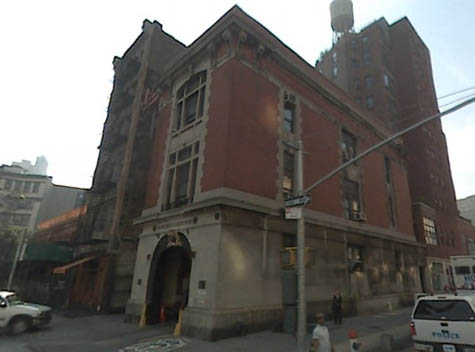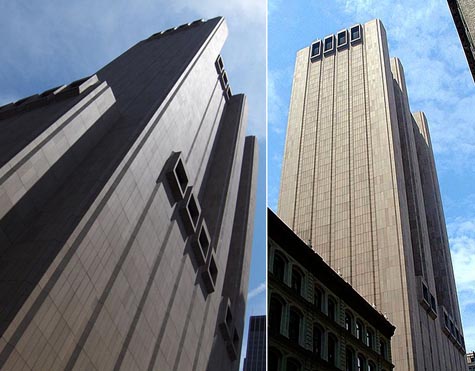 [Image: The original fire house from Ghostbusters, seen here via Google Street View].
[Image: The original fire house from Ghostbusters, seen here via Google Street View].
Every once in a while it’s rumored that there will be a Ghostsbusters III – the current rumor being that Judd Apatow might produce – and so, today, while walking around the National Gallery of Modern Art here in Rome, in a state of 100º exhaustion, I got to thinking about what would make an interesting plot if BLDGBLOG were somehow hired to write the screenplay.
And this is what I came up with:
It’s 1997. NYNEX is on the verge of being purchased by Bell Atlantic, after which point it will be dissolved in all but name.
But all hell starts breaking loose. Pay phones ring for no reason, and they don’t stop. Dead relatives call their families in the middle of the night. People, horrifically, even call themselves – but it’s the person they used to be, phoning out of the blue, warning them about future misdirection.
Every once in a while, though, something genuinely bad happens: someone answers the phone… and they go a little crazy.
Thing is – spoiler alert – halfway through the film, the Ghostbusters realize that NYNEX isn’t a phone system at all: it’s the embedded nervous system of an angel – a fallen angel – and all those phone calls and dial-up modems in college dorm rooms and public pay phones are actually connected into the fiber-optic anatomy of a vast, ethereal organism that preceded the architectural build-up of Manhattan.
Manhattan came afterwards, that is: NYNEX was here first.
It’s worth recalling, in fact, that NYNEX – at least according to Wikipedia – actually stood for New York/New England, “with the X representing the unknown future (or ‘the uneXpected’).” It’s like Malcolm X’s telephonically inclined, wiry cousin.
So the phone system of Manhattan – all those voices! all those connections! leading one life to another – starts to act up, provoked by its dissolution into Bell Atlantic… and the Ghostbusters are called in to fix it.
Fixing it involves rapid drives from telephone substation to telephone substation, from library to library, all while Dan Ackroyd’s character keeps receiving phone calls about a family crisis… his ex-wife is calling… his dad is calling… they’re urging him to stop this whole, crazy Ghostbusters business… He starts acting funny. The voices on the phone say strange things. They call at strange hours. He feels kinship with public pay phones; they sometimes ring as he walks past. He tries to call his family back – but they’re not answering.
Harold Ramis starts to suspect something.
In the background there are shadowy figures called out to fix transmission lines – but they are actually wiring something up… something big…
The whole movie then leads up to the granddaddy of them all: an electromagnetic confrontation inside the windowless, Brutalist telephone switching tower at 33 Thomas Street (rumored haunt of the ghost of Aleister Crowley).
 [Image: 33 Thomas Street, via Wikipedia, “is a telephone exchange or wire center building which contains three major 4ESS switches used for interexchange (long distance) telephony…”].
[Image: 33 Thomas Street, via Wikipedia, “is a telephone exchange or wire center building which contains three major 4ESS switches used for interexchange (long distance) telephony…”].
The opening scene: a pay phone on a sun-splashed street near Washington Square Park. You can see the famous arch in the background.
A man is sitting nearby, outside a deli. He’s got a bagel and a coffee and he’s reading the New York Times.
The phone starts to ring. He looks at it. It rings and rings.
He gets up, finally, and approaches the phone – and he answers it.
It’s his dad.
But he thought his dad was dead.
Ghostbusters III.
The city’s telecommunications system is not some mere collection of copper wires and fiber optics, the film will suggest; it’s actually the subtle anatomy of a barely understood supernatural being, an angel of rare metals embedded in the streets of Manhattan.
Somewhere between AT&T and H.P. Lovecraft, by way of electromagnetized Egyptian mythology.
These metals, Harold Ramis will explain, pushing up his eyeglasses, also correspond to materials used in pre-Christian burial rituals throughout Mesopotamia. Copper coffins. Traces of selenium found in embalming tools. He refers to Tiamat, dragon of multiple heads, and he draws mind-bending parallels between Middle Eastern mythology and the origins of NYNEX. NYNEX/Tiamat. NYNEX/Michael. NYNEX/Metatron.
Certain members of the audience think the whole thing sounds like bullshit. But they like the special effects. And who cares, anyway.
So the movie will involve everyone from Guglielmo Marconi to Thomas Edison to Alexander Graham Bell (he’s the “ultimate sorcerer,” Dan Ackroyd exclaims, laughing along with the rest of us), and it will make reference to the hundreds of architecturally interesting telephone substations scattered throughout the greater New York region.
It’s voodoo meets urban infrastructure by way of Avital Ronell. Architecture students will flock to see it.
Having seen the film, people will long for the days of pay telephones – when, according to the film’s mythology, you were actually using the body of an angel to make local phone calls.
Within the film, then, there are also brief scenes of excavation – a kind of angelic archaeology wherein Bill Murray digs through the plaster of tenement walls in search of ancient trunk lines. But he accidentally breaks into the plumbing.
At one point, he and Ernie Hudson drive north along the Hudson, discussing Christian archangels, afraid to use the car phone, looking for some kind of old anchorage point for the phone system.
They think maybe they can just shut the whole thing off.
They are surrounded by dark trees and the scenography is breath-taking.
Harold Ramis then uncovers a diagram of city streets and the exact locations of NYNEX lines; these line up with other diagrams from some Central European grimoire that he finds down in the basement of the New York Public Library.
They’re getting close, in other words.
And that’s when they discover 33 Thomas Street.
In any case, the film is released in the summer of 2012 and it’s a runaway blockbuster. It’s “a return to American mythmaking,” A.O. Scott writes in the New York Times, and there’s immediate talk of a Ghostbusters IV.
Manhattan is the wired center of a vast, global haunting, a transmission point crisscrossed by whispers above a magical infrastructure no one fully understands.
Ghostbusters III: hire me, and I’ll write it! I don’t think it’d be a bad movie, actually.